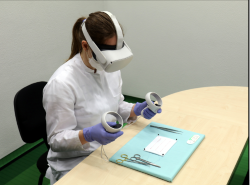Effect of Head-Mounted Displays on Students’ Acquisition of Surgical Suturing Techniques Compared to an E-Learning and Tutor-Led Course: A Randomized Controlled Trial

Background: Although surgical suturing is one of the most important basic skills, many medical school graduates do not acquire sufficient knowledge of it due to its lack of integration into the curriculum or a shortage of tutors. E learning approaches attempt to address this issue but still rely on the involvement of tutors. Furthermore, the learning experience and visual spatial ability appear to play a critical role in surgical skill acquisition. Virtual reality head-mounted displays (HMDs) could address this, but the benefits of immersive and stereoscopic learning of surgical suturing techniques are still unclear.
Material and Methods: In this multi-arm randomized controlled trial, 150 novices participated. Three teaching modalities were compared: an e-learning course (monoscopic), an HMD-based course (stereoscopic, immersive), both self-directed, and a tutor-led course with feedback. Suturing performance was recorded by video camera both before and after course participation (>26 hours of video material) and assessed in a blinded fashion using the OSATS Global Rating Score (GRS). Furthermore, the optical flow of the videos was determined using an algorithm. The number of sutures performed was counted, visual spatial ability was measured with the mental rotation test (MRT), and courses were assessed with questionnaires.
Results: Students' self-assessment in the HMD-based course was comparable to that of the tutor-led course and significantly better than in the e-learning course (P=0.003). Course suitability was rated best for the tutor-led course (x=4.8), followed by the HMD-based (x=3.6) and e-learning (x=2.5) courses. The median GRS between courses was comparable (P=0.15) at 12.4 (95% CI 10.0 12.7) for the e-learning course, 14.1 (95% CI 13.0-15.0) for the HMD-based course, and 12.7 (95% CI 10.3-14.2) for the tutor-led course. However, the GRS was significantly correlated with the number of sutures performed during the training session (P=0.002), but not with visual-spatial ability (P=0.626). Optical flow (R2=0.15, P<0.001) and the number of sutures performed (R2=0.73, P<0.001) can be used as additional measures to GRS.
Conclusion: The use of HMDs with stereoscopic and immersive video provides advantages in the learning experience and should be preferred over a traditional web application for e-learning. Contrary to expectations, feedback is not necessary for novices to achieve a sufficient level in suturing; only the number of surgical sutures performed during training is a good determinant of competence improvement. Nevertheless, feedback still enhances the learning experience. Therefore, automated assessment as an alternative feedback approach could further improve self-directed learning modalities. As a next step, the data from this study could be used to develop such automated AI-based assessments.
@Article{Peters2023,
author = {Philipp Peters and Martin Lemos and Andrea Bönsch and Mark Ooms and Max Ulbrich and Ashkan Rashad and Felix Krause and Myriam Lipprandt and Torsten Wolfgang Kuhlen and Rainer Röhrig and Frank Hölzle and Behrus Puladi},
journal = {International Journal of Surgery},
title = {Effect of head-mounted displays on students' acquisition of surgical suturing techniques compared to an e-learning and tutor-led course: A randomized controlled trial},
year = {2023},
month = {may},
volume = {Publish Ahead of Print},
creationdate = {2023-05-12T11:00:37},
doi = {10.1097/js9.0000000000000464},
modificationdate = {2023-05-12T11:00:37},
publisher = {Ovid Technologies (Wolters Kluwer Health)},
}

